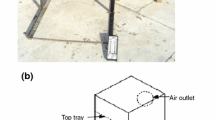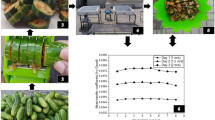Abstract
The convective heat transfer coefficient is an essential parameter for designing of any solar drying system. In this paper heat transfer modeling in term of convective heat transfer coefficient is performed and compared with open sun drying. The data obtained from experimentation under open sun and indirect solar drying conditions have been used to find values of the experimental constant ‘C’ and exponent ‘n’ by regression analysis and, consequently, convective heat transfer coefficient. From this study it is concluded that the convective heat transfer coefficient is decreasing with drying time it is due to decrease in moisture content. Results also showed that convective heat transfer coefficients are more in indirect solar dryer system than under open sun drying.









Similar content being viewed by others
Abbreviations
- A t :
-
Area of tray (m2)
- C 0 :
-
Constant in straight line equation
- C :
-
Experimental constant
- DR :
-
Drying rate (kg/h)
- g:
-
Acceleration due to gravity (m/s2)
- Gr :
-
Grashof number \(\left( {\frac{{g\beta X^{3} \rho^{2} \varDelta T}}{{\mu^{2} }}} \right)\)
- h c :
-
Convective heat transfer coefficient (W/m2 °C)
- K h :
-
Thermal conductivity of the humid air (W/m °C) \(\left( {\frac{\mu C}{{K_{h} }}} \right)\)
- m:
-
Tangent slope in straight line equation
- M ev :
-
Moisture evaporated (kg)
- n :
-
Exponent
- Nu :
-
Nusselt number
- P(T M ):
-
Partial vapour pressure of air at the crop surface (N/m2)
- P(T e ):
-
Partial vapour pressure of air at just above the crop surface (N/m2)
- Pr natural :
-
Prandtl number for natural circulation
- Pr forced :
-
Prandtl number for forced circulation
- Re :
-
Reynolds number \(\left( {\frac{vx}{\nu }} \right)\)
- Qe :
-
Rate of heat utilized (J/m2s)
- ∆T :
-
Effective temperature difference (°C)
- T :
-
Time (s)
- Tc-1,2,3:
-
Temperature of crop on first, second and third tray
- T e :
-
Temperature at just above the crop surface (°C)
- T M :
-
Temperature at the crop surface (°C)
- Ti :
-
Mean temperature of TM and Te (°C)
- T-1:
-
First tray
- T-2:
-
Second tray
- T-3:
-
Third tray
- v:
-
Velocity of air (m/s)
- X :
-
Characteristics length (m)
- β :
-
Expansion factor
- γ :
-
Relative humidity (%)
- ʋ :
-
Kinematic viscosity of humid air (m2/s)
- µ :
-
Viscosity of humid air (NS/m2)
- ρ :
-
Density of humid air (kg/m3)
- λ :
-
Latent heat of vaporization (J/kg)
References
Tremblay C, Cloutier A, Fortin Y (2000) Experimental determination of the convective heat and mass transfer coefficients for wood drying. Wood Sci Technol 34:253–276
Satcunanathan S, Deonaraine D (1973) A two pass solar air-heater. Sol Energy 15:41–49
Salameh T, Alami AH, Sunden B (2015) Experimental investigation of the effect of variously-shaped ribson local heat transfer on the outer wall of the turning portion of a U channel inside solar air heater. Heat Mass Transf. doi:10.1007/s00231-015-1541-3
Karim MA, Hawlader MNA (2006) Performance investigation of flat plate, v-corrugated and finned air collector. Energy 31:452–470
Singh S, Dhiman P (2014) Thermal and thermohydraulic performance evaluation of a novel type double pass packed bed solar air heater under external recycle using an analytical and RSM (response surface methodology) combined approach. Energy 72:344–359
Dhiman P, Singh S (2015) Recyclic double pass packed bed solar air heaters. Int J Therm Sci 87:215–227
Sodha MS, Dang A, Bansal PK, Sharman SB (1985) An analytical and experimental study of open sun drying and cabinet type drier. Energy Convers Manage 25:263–271
Kumar S, Tiwari GN (1996) Estimation of convective mass transfer in solar distillation system. Sol Energy 57:459–464
Goyal RK, Tiwari GN (1998) Heat and mass transfer relations for crop drying. Drying Technol 16:1741–1754
Anwar SI, Tiwari GN (2001) Evaluation of convective heat transfer coefficient in crop drying under open sun drying conditions. Energy Convers Manage 42:627–637
Jain D, Tiwari GN (2003) Thermal aspect of open sun drying of various crops. Energy 28:37–54
Jain D, Tiwari GN (2004) Effect of greenhouse on crop drying under natural and forced convection I: evaluation of convective mass transfer coefficient. Energy Convers Manage 45:765–783
Tiwari GN, Kumar S, Prakash O (2004) Evaluation of convective mass transfer coefficient during drying of Jaggery. J Food Eng 63:219–227
Kumar A, Tiwari GN (2006) Effect of shape and size on convective mass transfer coefficient during greenhouse drying (GHD) of jaggery. J Food Eng 73:121–134
Barnwal P, Tiwari GN (2008) Grape drying by using hybrid photovoltaic-thermal (PV/T) greenhouse dryer: an experimental study. Sol Energy 82:1131–1144
Tripathy PP, Abhishek S, Bhadoriya PBS (2014) Determination of convective heat transfer coefficient and specific energy consumption of potato of using an ingenious self tracking solar dryer. J Food Meas Charact 8:36–45
Prakash O, Kumar A (2014) Performance evaluation of greenhouse dryer with opaque north wall. Heat Mass Transf 50:493–500
Jain D (2006) Determination of convective heat and mass transfer coefficients for solar drying of fish. Biosyst Eng 94:429–435
Sunil, Varun, Sharma N (2014) Experimental investigation of the performance of an indirect-mode natural convection solar dryer for drying fenugreek leaves. J Therm Anal Calorim 118:523–531
Kumar A, Tiwari GN (2007) Effect of mass on convective mass transfer coefficient during open sun and greenhouse drying of onion flakes. J Food Eng 79:1337–1350
Tiwari GN (2006) Solar energy: fundamentals, design, modelling and application. Narosa publishing house, India
Author information
Authors and Affiliations
Corresponding author
Appendix
Appendix
The physical property of humid air such as specific heat (C), thermal conductivity (Kh), dynamic viscosity, density (ρ), Kinematic viscosity (ν) and expansion factor (β) is obtained by using mean value of crop temperature (TM) and air temperature just above the crop (Te) [14, 21]
Rights and permissions
About this article
Cite this article
Shrivastava, V., Kumar, A. Experimental investigation on the comparison of fenugreek drying in an indirect solar dryer and under open sun. Heat Mass Transfer 52, 1963–1972 (2016). https://doi.org/10.1007/s00231-015-1721-1
Received:
Accepted:
Published:
Issue Date:
DOI: https://doi.org/10.1007/s00231-015-1721-1




